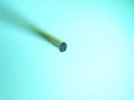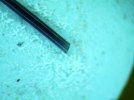The theory is that the force to initiate the cut is greater than the force to complete the cut, so the goal is to penetrate a few microns, or maybe tens of microns and then the fibre cleaves. ...
Just thinking out loud.
So if it's the initiating of the cut that is most important, it would seem that a fairly coarse and very acute edge -- say 10 degrees inclusive sharpened with 400-grit diamonds and followed by polishing the edge with high-grit stones (5,000 grit plus) and then stropped with .25 diamonds would be a good strategy.
The coarse edge would contain a lot of very sharp teeth that might initiate the cut easily -- like it's easier to push a pointy knife tip into a tomato than it is to push cut into the tomato with with the edge.
It doesn't seem like the edge width at the shoulders (BTE) would help much, but the angle of the edge would. And I'd guess that the sharpness of the apex would be more important than the angle.


